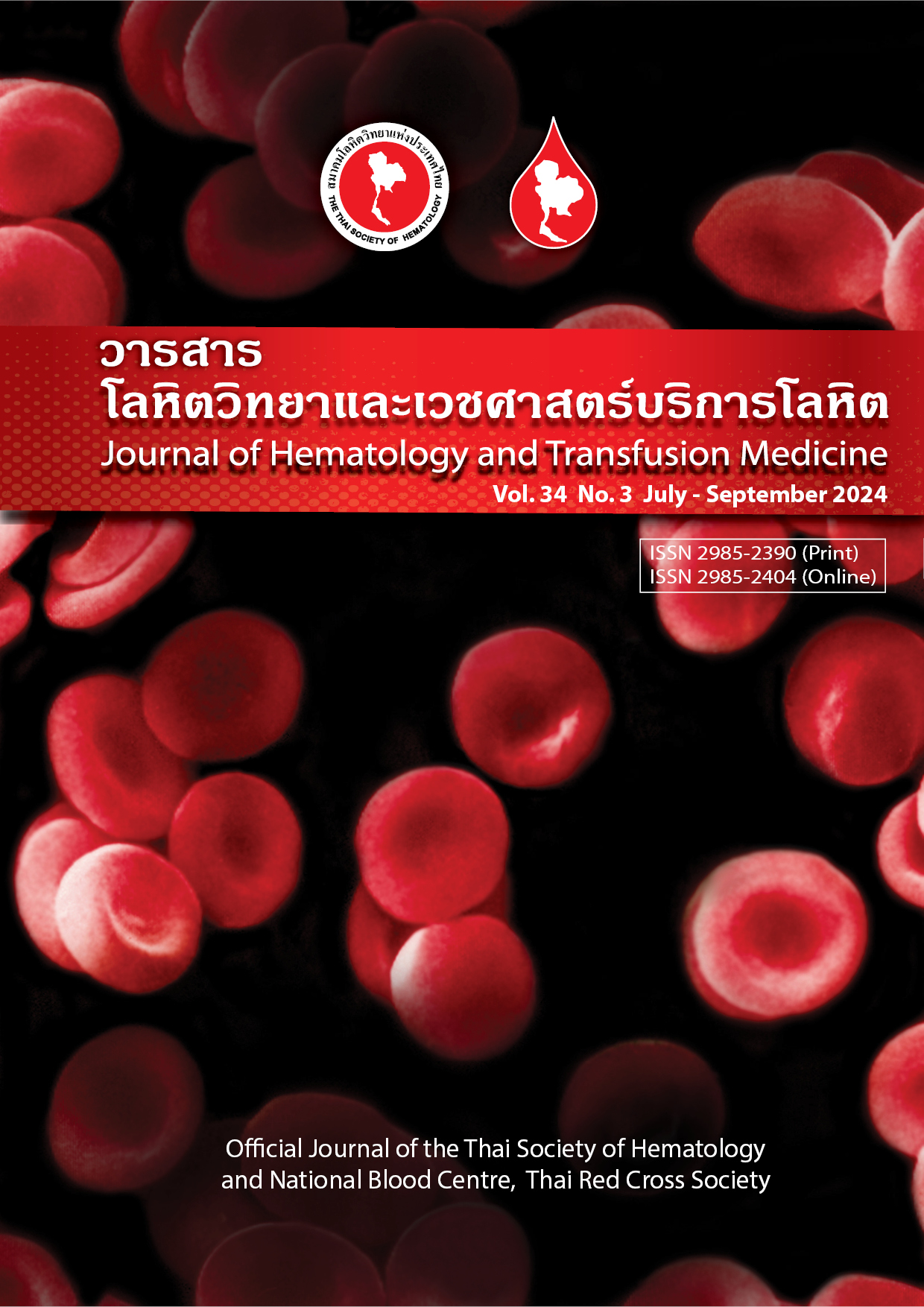การตรวจหาแอนติบอดีบนผิวเม็ดเลือดแดงในผู้ป่วยโรค autoimmune hemolytic anemia (AIHA) โดยวิธี flow cytometry เปรียบเทียบกับวิธี direct antiglobulin test
คำสำคัญ:
โรคโลหิตจางจากภูมิคุ้มกันทำลายเม็ดเลือดแดงตนเอง, การทดสอบไดเรกต์แอนติโกลบูลิน, การทดสอบไดเรกต์คูมบส์, โฟลว์ไซโตเมทรีบทคัดย่อ
บทคัดย่อ
บทนำ Autoimmune hemolytic anemia (AIHA) เป็นภาวะที่ร่างกายสร้างแอนติบอดีต่อเม็ดเลือดแดงทำให้เกิดการทำลายเม็ดเลือดแดงขึ้น การวินิจฉัยภาวะนี้อาศัยอาการทางคลินิก ผลตรวจทางห้องปฏิบัติการพบหลักฐานการแตกของเม็ดเลือดแดง และการตรวจพบแอนติบอดีบนผิวเม็ดเลือดแดง อย่างไรก็ตามมีผู้ป่วย AIHA บางรายที่ตรวจไม่พบแอนติบอดีบนผิวเม็ดเลือดแดงทำให้เกิดความลำบากในการวินิจฉัย flow cytometry เป็นวิธีการตรวจที่สามารถพบแอนติบอดีชนิด IgG ปริมาณน้อยบนผิวเซลล์ได้จึงอาจช่วยเพิ่มความสามารถในการวินิจฉัยผู้ป่วย AIHA วัตถุประสงค์ เพื่อเปรียบเทียบความสามารถในการวินิจฉัยภาวะ AIHA ระหว่างการตรวจด้วยวิธี flow cytometry และวิธี direct antiglobulin test (DAT) วัสดุและวิธีการ DAT ตรวจโดย column agglutination technology (CAT) ซึ่งใช้น้ำยา Coombs’ reagent แบบหลายความจำเพาะที่สามารถตรวจพบได้ทั้ง IgG และ C3d ส่วน flow cytometry ตรวจโดยใช้น้ำยาที่สามารถตรวจพบได้เฉพาะ IgG และมีการตรวจตัวอย่างควบคุมแบบลบพร้อมกันทุกครั้ง เกณฑ์ตัดสินผลบวกของ flow cytometry ได้จากการตรวจตัวอย่างเลือดจากผู้ที่มีสุขภาพดี หลังจากนั้นตัวอย่างเลือดจากผู้ป่วยที่ได้รับการส่งตรวจ DAT จะได้รับการตรวจด้วยวิธี flow cytometry ด้วย ผู้ป่วยที่มีหลักฐานการแตกของเม็ดเลือดแดงจะได้รับการตรวจเพิ่มเติมเพื่อหาสาเหตุต่อไป ผลการศึกษา เกณฑ์การตัดสินผลบวกของ flow cytometry ได้จากผู้ที่มีสุขภาพดี 41 ราย ในระยะที่สองของการศึกษาจากผู้ป่วยทั้งหมด 185 ราย มี 44 รายที่มีภาวะ AIHA การตรวจโดยวิธี flow cytometry มีความไว 90.9% (95% CI = 78.3 – 97.5) และความจำเพาะ 66.0% (57.5 – 73.7) ส่วนวิธี DAT มีความไว 88.6% (75.4 – 96.2) และความจำเพาะ 61.7% (53.2 – 69.8) พบว่า flow cytometry ช่วยในการวินิจฉัยผู้ป่วย AIHA ได้เพิ่มเติม 5 รายซึ่งเกิดจาก IgG ปริมาณน้อย แต่ให้ผลลบในผู้ป่วย AIHA ที่เกิดจาก IgM 2 ราย และ low-affinity IgG 2 ราย สรุป Flow cytometry สามารถใช้ในการวินิจฉัย AIHA ได้โดยมีความไวและความจำเพาะที่ดี นอกจากนี้ยังช่วยในการวินิจฉัยผู้ป่วย AIHA ที่ให้ผลลบกับการตรวจ DAT เนื่องจากปริมาณ IgG ที่น้อยเกินไปได้ด้วย ทั้งนี้ flow cytometry ก็มีข้อจำกัดคือไม่สามารถตรวจพบแอนติบอดีชนิดอื่น หรือ low-affinity IgG การใช้ flow cytometry ร่วมกับ DAT สามารถช่วยเพิ่มความไวในการวินิจฉัย AIHA ได้
Abstract:
Introduction: Autoimmune hemolytic anemia (AIHA) is a condition in which the body produces antibodies against red blood cells, leading to their destruction. Diagnosis relies on clinical symptoms, laboratory evidence of hemolysis, and the detection of antibodies on red blood cells. However, there are some patients with AIHA who lack detectable antibodies, this leads to diagnostic challenges. Based upon the fact that flow cytometry can detect low level of IgG on cells, the chance to detect patients with AIHA is potentially increased. Objective: To compare the diagnostic capabilities of flow cytometry versus the current method of direct antiglobulin test (DAT) in diagnosing AIHA Materials and Methods: DAT is performed using column agglutination technology (CAT) with polyspecific Coombs' reagent, capable of detecting both IgG and C3d. Flow cytometry is performed using reagents that can only detect IgG, and negative control testing is conducted each time. Blood samples from healthy individuals were studied to establish a cut-off for flow cytometry. Then blood samples from patients who underwent DAT were examined using flow cytometry. Patients with laboratory evidence of hemolysis were further tested to identify the underlying cause. Results: The cut-off value for flow cytometry was determined from 41 healthy participants. In the second phase, 44 out of 185 had AIHA. Flow cytometry showed 90.9% sensitivity (95% CI = 78.3 – 97.5) and 66.0% specificity (57.5 – 73.7). DAT showed 88.6% sensitivity (75.4 – 96.2) and 61.7% specificity (53.2 – 69.8). Flow cytometry aids in diagnosing 5 cases of low-level IgG-mediated AIHA but yields negative results in 2 cases of IgM-mediated AIHA and 2 cases of low-affinity IgG-mediated AIHA. Conclusion: Flow cytometry can be used to aid in the diagnosis of AIHA with good sensitivity and specificity. It also assists in diagnosing DAT negative AIHA caused by low levels of IgG but has limitations in detecting other type of antibodies and low-affinity IgG. Using flow cytometry in conjunction with DAT can enhance the sensitivity of AIHA detection.
Downloads
เอกสารอ้างอิง
Packman CH. Hemolytic Anemia Resulting from Immune Injury. In: Kaushansky K, Lichtman MA, Prchal JT, Levi MM, Press OW, Burns LJ, et al., editors. Williams Hematology, 9e [Internet]. New York, NY: McGraw-Hill Education; 2015 [cited 2024 Jan 2]. Available from: accessmedicine.mhmedical.com/content.aspx?aid=1121094665.
Park SH. Diagnosis and treatment of autoimmune hemolytic anemia: classic approach and recent advances. Blood Res. 2016;51:69–71.
Gehrs BC, Friedberg RC. Autoimmune hemolytic anemia. Am J Hematol. 2002;69:258–71.
Barcellini W, Fattizzo B. Clinical applications of hemolytic markers in the differential diagnosis and management of hemolytic anemia. Dis Markers. 2015;2015:635670. doi: 10.1155/2015/635670.
Garratty G. Immune hemolytic anemia associated with negative routine serology. Semin Hematol. 2005;42:156–64.
Segel GB, Lichtman MA. Direct antiglobulin (“Coombs”) test-negative autoimmune hemolytic anemia: a review. Blood Cells Mol Dis. 2014;52:152–60.
Sachs UJH, Röder L, Santoso S, Bein G. Does a negative direct antiglobulin test exclude warm autoimmune haemolytic anaemia? a prospective study of 504 cases. Br J Haematol. 2006 ;132:655–6.
Thedsawad A, Taka O, Wanachiwanawin W. Significances of red cell bound immunoglobulin G as detected by flow cytometry in patients with Coombs-negative immune hemolysis. Transfus Med Oxf Engl. 2016;26:130–7.
Alzate MA, Manrique LG, Bolaños NI, Duarte M, Coral-Alvarado P, González JM. Simultaneous detection of IgG, IgM, IgA complexes and C3d attached to erythrocytes by flow cytometry. Int J Lab Hematol. 2015;37:382–9.
Sokol RJ, Booker DJ, Stamps R, Jalihal S, Paul B. Direct Coombs test-negative autoimmune hemolytic anemia and low-affinity IgG class antibodies. Immunohematology. 1997;13:115–8.
Garratty G. Effect of cell-bound proteins on the in vivo survival of circulating blood cells. Gerontology. 1991;37:68–94.
Garratty G, Arndt PA. Applications of flow cytofluorometry to red blood cell immunology. Cytometry. 1999;38:259–67.
McHugh ML. Interrater reliability: the kappa statistic. Biochem Medica. 2012;22:276–82.
Schober P, Boer C, Schwarte LA. Correlation coefficients: appropriate use and interpretation. Anesth Analg [Internet]. 2018;126(5). Available from: https://journals.lww.com/anesthesia-analgesia/fulltext/2018/05000/correlation_coefficients__appropriate_use_and.50.aspx.
Kamesaki T, Kajii E. A Comprehensive diagnostic algorithm for direct antiglobulin test-negative autoimmune hemolytic anemia reveals the relative ratio of three mechanisms in a single laboratory. Acta Haematol. 2018;140:10–7.
Kay MM. Mechanism of removal of senescent cells by human macrophages in situ. Proc Natl Acad Sci U S A. 1975;72:3521–5.
Kay MM. Aging of cell membrane molecules leads to appearance of an aging antigen and removal of senescent cells. Gerontology. 1985;31:215–35.
Lutz HU. Naturally occurring autoantibodies in mediating clearance of senescent red blood cells. Adv Exp Med Biol. 2012;750:76–90.
Thiagarajan P, Parker CJ, Prchal JT. How do red blood cells die? Front Physiol. 2021;12:655393. doi: 10.3389/fphys.2021.655393.
Kamesaki T. Diagnostic algorithm for classification and characterization of direct antiglobulin test-negative autoimmune hemolytic anemia with 1-year clinical follow-up. Transfusion (Paris). 2022;62:205–16.
Takahashi T. Direct antiglobulin test-negative autoimmune hemolytic anemia. Acta Haematol. 2018 13;140:18–9.
ดาวน์โหลด
เผยแพร่แล้ว
ฉบับ
ประเภทบทความ
สัญญาอนุญาต
ลิขสิทธิ์ (c) 2024 วารสารโลหิตวิทยาและเวชศาสตร์บริการโลหิต

อนุญาตภายใต้เงื่อนไข Creative Commons Attribution-NonCommercial-NoDerivatives 4.0 International License.



